Notes: Hessay was one of the stations on the railway between York and Harrogate. The line is still open and thriving although it was on Beeching’s closure list. The western end of this route originated on 21 July 1845 when the Leeds & Thirsk Railway (L&T) was authorised to construct a branch from its planned main line at Starbeck (where it skirted the eastern fringe of Harrogate) to Knaresborough. The East & West Yorkshire Junction Railway (EWYJ) – described by Hoole (1974) as a protégé of George Hudson’s York & North Midland Railway (YNM) – was authorised on 16 July 1846 to build from York to Knaresborough. The L&T seemed to be showing excessive interest in the EWYJ in 1847, but Hudson’s influence won the day. At the opening the line from Skelton Junction, where the new route diverged from the Hudson’s York, Newcastle & Berwick Railway, the latter company provided the motive power. The western terminus at its opening on 30 October 1848 was at Hay Park Lane, about a mile east of Knaresborough. This temporary measure was necessary because the L&T’s viaduct over the River Nidd in Knaresborough collapsed on 11 March 1848 as it neared completion. The successfully completed structure was notable for its castellated piers complementing the ruins of the nearby castle. On 21 July 1851 the Leeds Northern Railway (renamed from L&T on 3 July) branch from Starbeck opened to meet the line from York at Knaresborough. What is now Starbeck station was identified in Bradshaw by various names – including Harrogate, Harrogate & Knaresborough, High Harrogate and Harrogate High – until it settled down to be Starbeck in 1857. Trains on the Leeds and Wetherby lines used another Harrogate station (the terminus usually suffixed ‘Brunswick’ in modern literature to distinguish it from the present station which replaced it in 1862).
From 1851 the EWYJ operated its own motive power with the assistance of E B Wilson & Co, locomotive builders of Leeds. On 28 May 1852 the EWYJ was absorbed into the YNM company; the L&T had been renamed the Leeds Northern Railway (LN) on 3 July 1851; and both the YNM and LN companies became part of the newly-formed North Eastern Railway in 1854. The present Harrogate station opened on 1 August 1862; it became the western terminus of the line from York and replaced the Brunswick terminus, as mentioned above.
 The intention of the EWYJ was to provide three large wayside stations between York and Knaresborough at Poppleton, Marston (later Marston Moor) and Cattal; a fourth was added at Allerton (later Hopperton), and all four opened with the line in 1848. Within two years further stations were provided at Hessay, Hammerton and Goldsborough level crossings, but it is possible that trains called at these places from the opening of the line; early passenger timetables for North East England are known to have omitted certain stations that were in use. In all three places there were level crossings, where the gatekeepers’ houses could be incorporated into a passenger station. The hamlet of Hessay was about half a mile south of the level crossing promising a modest amount of passenger traffic. The intention of the EWYJ was to provide three large wayside stations between York and Knaresborough at Poppleton, Marston (later Marston Moor) and Cattal; a fourth was added at Allerton (later Hopperton), and all four opened with the line in 1848. Within two years further stations were provided at Hessay, Hammerton and Goldsborough level crossings, but it is possible that trains called at these places from the opening of the line; early passenger timetables for North East England are known to have omitted certain stations that were in use. In all three places there were level crossings, where the gatekeepers’ houses could be incorporated into a passenger station. The hamlet of Hessay was about half a mile south of the level crossing promising a modest amount of passenger traffic.
At Hessay level crossing a single-storey house was already built for the gate keeper on the up (north) side of the tracks, east of the crossing. Fawcett (2001) notes that the accommodation was tiny: a living kitchen and a bedroom. The gatehouse was given chamfered stone quoins, a bay window looking out onto the line and a decorative wooden pendant on the gable.
In 1849 Hessay was provided with some formal passenger station buildings. Waiting rooms were constructed immediately east of the gatehouse and were given the distinction of a ‘mildly Gothic doorway in stone’ (Fawcett). The gatehouse was raised to two storeys, with quoins running all the way up and the original roof re-used. Facing platforms were provided east of the crossing. The up platform in front of the gatehouse and waiting rooms was scarcely above rail level, enabling them to be entered without steps down; the ramp up to the standard-height platform was immediately beyond the waiting rooms.
Up trains: weekdays May 1849 |
Destination |
Down trains: weekdays |
Destination (HPL: Hay Park Lane temporary terminus) |
8.37am |
York |
7.16am |
Knaresborough (HPL) |
1.47pm |
York |
12.16pm |
Knaresborough (HPL) |
6.52pm |
York |
5.26pm |
Knaresborough (HPL) |
Up trains: Sunday |
Destination |
Down trains: Sunday |
Destination |
9.47am |
York |
8.16am |
Knaresborough (HPL) |
6.49pm |
York |
5.16pm |
Knaresborough (HPL) |
Note: the published timetable simply calls the western destination ‘Knaresborough’.
As indicated in Reid’s Monthly Railway Time Table for May 1849 (above) trains travelled only as far west as Knaresborough – or, more correctly, to the temporary terminus at Hay Park Lane, about a mile short of Knaresborough.
Bradshaw of February 1863 shows weekday train frequencies little changed from 1849, but Sunday trains have been withdrawn. Not all trains call at Hessay. The Harrogate terminus is the present-day station which had opened in 1862.
Up trains: weekdays February 1863 |
Destination |
Down trains: weekdays |
Destination |
10.20am |
York |
7.37am ‡ |
Harrogate* |
12.44pm |
York |
10.27am |
Harrogate* |
5.04pm |
York |
2.02pm |
Harrogate* |
- |
- |
4.49pm ‡ |
Harrogate* |
Notes: ‡ Approximate time; calls by request *Timetable heading refers to the station as ‘High Harrogate’ – presumably owing to inertia, as High Harrogate had been named Starbeck since 1857.
The NER timetable for July 1896 shows an increased frequency of calls at Hessay but, once again, no Sunday trains. This is the situation shortly before road motor transport began to offer competition to the trains. The Wednesday-only arrival at 3.49pm is for passengers to alight having visited Knaresborough market.
Up trains: weekdays July 1896 |
Destination |
Down trains: weekdays |
Destination |
8.09am |
York |
7.33am |
Harrogate |
11.54am |
York |
10.27am |
Harrogate |
1.34pm |
York |
12.57pm |
Harrogate |
3.49pm (Wed only)* |
York |
3.37pm |
Harrogate |
5.19pm |
York |
5.17pm |
Harrogate |
8.24pm |
York |
8.02pm |
Harrogate |
Note: *Market Train
Freight sidings at Hessay were not shown on the OS 1: 2,500 map of 1893, but on the next edition (1909) five sidings are shown north-west of the level crossing, on the down side, the outermost with a long headshunt. Hoole (1985) notes that livestock was handled here in 1913 but that there were no general goods facilities, only ‘bulk traffic’ being dealt with.
The signalling at Hessay was controlled from an exposed frame on the low platform in front of the station house, and the crossing gates were manually opened and closed; these arrangements still apply in 2016.
Hessay station served a sparsely populated area. NER figures of 1911 reveal that only 368 people lived within its catchment and only 4,405 tickets were sold at the station that year. During World War 1, a number of lightly-used stations were closed to release staff for the military duties; these closures generally did not take place until 1916-17, but passenger trains ceased to call at Hessay as early as 20 September 1915. Perhaps the closeness of an alternative station at Marston Moor justified this decision. Once again, Hessay was unusual in that it did not have a distinct reopening date after the war was over. Quick (2009) notes that Bradshaw showed a service again in June 1919, but on Saturday only, for York passengers. In Reid’s York–Harrogate timetable of June 1920, ‘Hessay (closed)’ appears confusingly in the station bank, with a footnote that an up train calls (c9.15am) and a down train (c3.39pm), both on Saturday only ‘for York passengers’. Sometime between August 1921 and July 1922 trains resumed calling on all weekdays.
Information on Hessay’s stationmasters is incomplete, but the post was vacated in February 1912 by G E Tindall on his move to be stationmaster at Everingham, between Selby and Market Weighton. He was succeeded by C Bradley, who had previously been stationmaster at Hinderwell, north of Whitby, who was in post until November 1913 when he moved back to the Yorkshire coast as stationmaster at Ravenscar. In February 1914 J Taylor, a signalman at Normanton was promoted to stationmaster at Hessay. He was in post during the period when the station was closed to passengers and transferred in September 1920 to the quiet Husthwaite Gate station on the York-Helmsley / Malton line.

In the ‘Grouping’ of January 1923 the North Eastern Railway became part of the London & North Eastern Railway, one of the so-called ‘Big Four’. From February 1921 the stationmaster was C E Bowman; he had previously been acting relief clerk at Leeds. He stayed at Hessay until December 1932 when he moved on to be stationmaster at Weaverthorpe between Malton and Scarborough, one of the stations on the line that had recently been closed to passengers whilst continuing to handle goods traffic. Hessay continued its tranquil rural life, and ceased to have its own stationmaster, being placed under the supervision of Marston Moor; the date when this arrangement was made is not known, but it was probably from December 1932, when J Herbert was in post at Marston Moor. Hessay’s modest service of passenger trains continued – the poorest service of any of the stations between York and Harrogate, and with a noticeable imbalance between up and down train frequency. Note how early the last up train calls.
Up trains: weekdays July 1938 |
Destination |
Down trains: weekdays |
Destination |
8.04am |
York |
7.30am |
Harrogate |
9.11am |
York |
12.51pm |
Harrogate |
12.54pm |
York |
4.26pm |
Harrogate |
- |
- |
5.34pm |
Harrogate |
- |
- |
8.06pm ‡ |
Harrogate |
‡ Approximate time; calls by request
For much of its length the main road between York and Knaresborough (now the A59) was within a mile of the railway, and after World War 1 road motor services began to offer competition to trains. The local villages, however, with the exception of Green Hammerton, were some distance from this road, and buses would need to make numerous diversions from it to serve them adequately; thus (with the exception of Wilstrop Siding) the wayside stations would survive into the 1950s or, in the cases of Poppleton, Hammerton and Cattal, remain open today. This is in contrast to the lines between Malton and Scarborough, and Malton and Gilling, where all the villages were strung along a parallel main road, and their stations closed in 1930-31.
After the outbreak of hostilities in 1939, War Department sidings at Hessay were installed on the down side, north-west of the level crossing and south-west of the existing sidings. At Goldsborough, several stations west of Hessay, there were also significant wartime additions to the infrastructure of the York–Harrogate line in the form of a huge emergency cold store and a new blast-proof signal box. Stationmaster Herbert remained in post until the middle years of World War 2, retiring in June 1943 – he died in June 1964. Herbert was replaced by E A Temple in August 1943, and he was stationmaster of Marston Moor and Hessay until November 1946 when he was promoted to be in charge of Thorp Arch for Boston Spa station, near Wetherby. From February 1947 until June 1948 the post was filled by R J Shaw; he had previously been stationmaster at Naburn, between York and Selby, and when he left Marston Moor and Hessay he took charge of Castleton and Commondale stations, between Stockton and Whitby.
From 1 January 1948 Hessay station was within the nationalised British Railways’ North Eastern Region. The LNER had carried out no significant modernisation of the station: existing accommodation sufficed, as did the oil lighting of the platforms using North Eastern Railway lanterns. BR either installed new wooden nameboards or repainted the existing ones in North Eastern Region tangerine, and this was probably the sum total of the new administration’s improvements. The first BR timetable showed a slightly reduced service frequency compared to that provided by the LNER in 1938, still with fewer up trains.
Up trains: weekdays May 1948 |
Destination |
Down trains: weekdays |
Destination |
8.00am |
York |
7.27am |
Harrogate |
9.22am (Saturday only) |
York |
12.41pm (Sat excepted) |
Harrogate |
1.13pm |
York |
1.16pm (Saturday only) |
Harrogate |
- |
- |
4.35pm |
Harrogate |
- |
- |
5.26pm |
Harrogate |
Hessay station continued to be supervised by Marston Moor. During early British Railways years the stationmasters were J J Edmond from August 1948 (who transferred here from the neighbouring Hammerton station) then P Howarth from July 1950. This gentleman was previously in charge of Hickleton & Thurnscoe, a goods station on the old Hull & Barnsley Railway. He retired in June 1952, but two months earlier R Powell took the post, having previously been stationmaster at Pickburn & Brodsworth goods station near Doncaster. Mr Powell was the final stationmaster of Marston Moor and Hessay.
 Owing to the decline in use of rural stations, in the 1950s the neighbouring branch line from Harrogate to Pateley Bridge closed to passengers as did the branch from Knaresborough to Pilmoor on the East Coast main line. On the York–Harrogate route all stations that survived to nationalisation remained open, but in 1952/53 economies were effected by reducing the number of train calls at the quietest stations, making the services less attractive. Hessay’s train service was almost annihilated, as seen in the summer 1958 timetable. The only worthwhile return journey that could be made by train was a shopping/market trip to York on Saturday. Owing to the decline in use of rural stations, in the 1950s the neighbouring branch line from Harrogate to Pateley Bridge closed to passengers as did the branch from Knaresborough to Pilmoor on the East Coast main line. On the York–Harrogate route all stations that survived to nationalisation remained open, but in 1952/53 economies were effected by reducing the number of train calls at the quietest stations, making the services less attractive. Hessay’s train service was almost annihilated, as seen in the summer 1958 timetable. The only worthwhile return journey that could be made by train was a shopping/market trip to York on Saturday.
Up trains: weekdays June 1958 |
Destination |
Down trains: weekdays |
Destination |
8.00am |
York |
7.27am |
Harrogate |
9.28am (Saturday only) |
York |
12.38pm (Saturday only) |
Harrogate |
The above timetable was to be Hessay’s last. On 15 September 1958 there was a purge of wayside stations in the North Eastern Region, principally affecting the East Coast main line, but four of the least-used York-Harrogate stations also closed to passengers on that day: Hessay, Marston Moor, Hopperton and Goldsborough. Freight continued to be handled at Hessay until May 1964, but the former WD (by this time Ministry of Defence) sidings remained in use.
In March 1963 the Reshaping of British Railways (‘Beeching Report’) recommended the closure of the Harrogate-York line, which probably came as little surprise as the train service was not especially frequent and the A59 road ran close to the railway for its entire length. However, in September 1966 the Minister of Transport, Barbara Castle, rejected closure on the grounds of hardship that this would cause. There was no immediate evidence of investment in the reprieved line. Like its neighbours at Goldsborough and Marston Moor, Hessay station survived almost intact for well over a decade after passenger services ceased, with both of its platforms and even the nameboards in place.
Operating economies were exercised by British Rail in the 1970s. Single-line working commenced on 4 June 1972 between Poppleton and Hammerton; the up line was removed through Hessay station by May 1973. The section between Cattal and Knaresborough was similarly downgraded on 16 December 1973 with the redundant track being recovered by 3 March 1974.
The WD sidings at Hessay continued to be used by the Ministry of Defence until 1991, identified as ‘Engineering Stores Depot’ on the OS 1: 2,500 map of 1968. The sidings were latterly served by one train per week. The last rail use of the site was for storage of surplus stock from the National Railway Museum. For many years it was possible from the A59 road to see a long line of derelict and unrestored wagons. The stock was eventually removed by road. The rail freight company EWS developed a scheme circa early 2002 with Tarmac for a large rail-served aggregate depot on the site of the old army depot but owing to local opposition the development did not take place. The connection with the York–Harrogate line has been removed for some time although what was known as Hessay WD GF was, until recently, officially ‘live’; some of the track in the sidings is extant. The sidings area is now an industrial estate.
In 1998 both platforms were still intact at Hessay, but the down platform was removed circa 2007 for use as fill material after a landslip adjacent to Arthington Viaduct, between Harrogate and Leeds. The gate keeper at Hessay works from the former station office where the communication equipment with adjacent boxes is housed. However there is an open ground frame on the old platform, in front of the station building and adjacent to the crossing.
One of the curiosities of the York–Harrogate line is that in 2016 it remains a stronghold of semaphore signals and manually operated, attended level crossing gates, as at Hessay. There are probably several factors at work to explain this. At present there is no problem with availability of staff for these duties. The equipment installed when track-singling was carried out in the 1970s is still serviceable, and with restoration of double track and even electrification in prospect it would make little sense to automate the crossings and train control until it is clear how and when the route will be upgraded – which surely will happen soon. Once considered expendable, the York-Harrogate route has gone from strength to strength with an hourly weekday service operating to and from Leeds and stopping at all stations; a further hourly service runs between Knaresborough, Harrogate and Leeds, and there are also frequent Sunday trains. On a number of recent journeys between Harrogate and York the author has noted that the trains are well-used, sometimes with standing room only, even outside the rush hour. Organised holidays tours based in Harrogate but visiting York for the day provide many passengers for the line during the summer half of the year. Whatever the future holds for the York-Harrogate line, there can be no justification for reopening Hessay station.
I am grateful for information received from Mark Robertshaw (Programme Development Manager, Network Strategy and Capacity Planning, Network Rail) that has been included in this page.
Tickets from Michael Stewart. Route map drawn by Alan Young
BIBLIOGRAPHY:
- Bairstow, Martin Railways around Harrogate: Vol 1 (Author, 1989)
- Biddle, Gordon Victorian stations (David & Charles, 1973)
- Biddle, Gordon Britain’s historic railway buildings (Oxford University Press, 2003)
- Clinker, C R Clinker’s register of closed passenger stations and goods depots (Avon-Anglia, 1978)
- Fawcett, Bill A history of North Eastern Railway architecture: Vol 1 The Pioneers (North Eastern Railway Association, 2001)
- Goode, C T The York, Knaresborough and Harrogate Railway (Author, 2001)
- Hoole, Ken A regional history of the railways of Great Britain: Vol 4 The North East (David & Charles, 1974)
- Hoole, Ken Railway stations of the North East (David & Charles, 1985)
- Quick, Michael Railway passenger stations in Great Britain: a chronology (Railway & Canal Historical Society, 2009)
- Signalling website
To see other closed station on the York - Harrogate line click on the station name: Marston Moor, Wilstrop Siding, Hopperton, Goldsborough & Knaresborough (Hay Park Lane) |

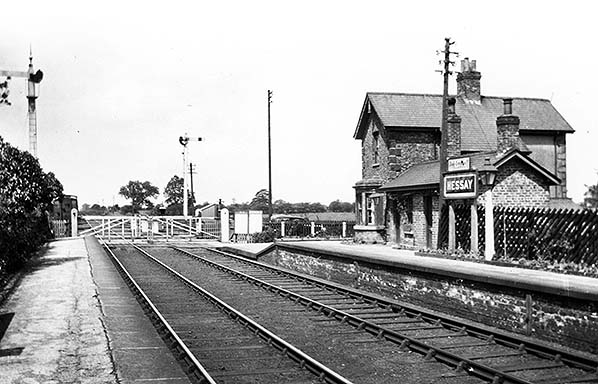

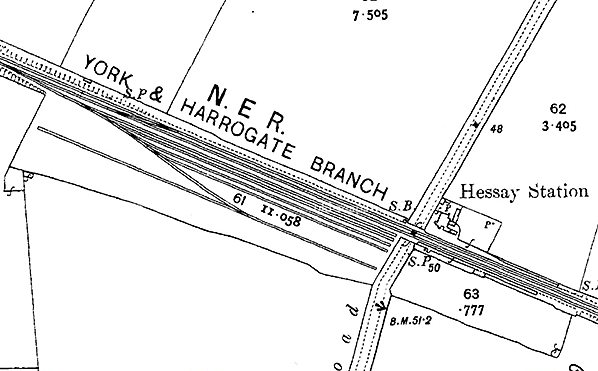
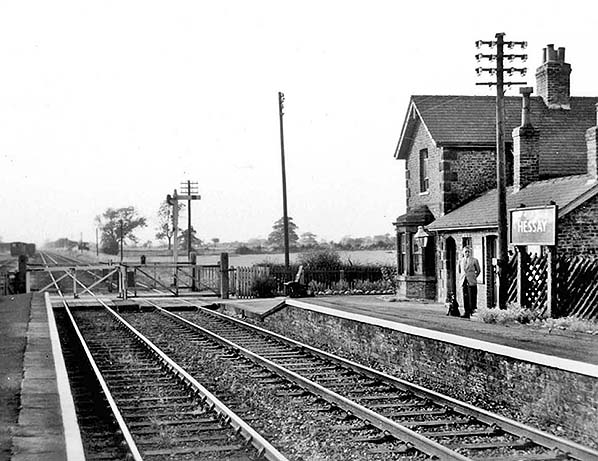
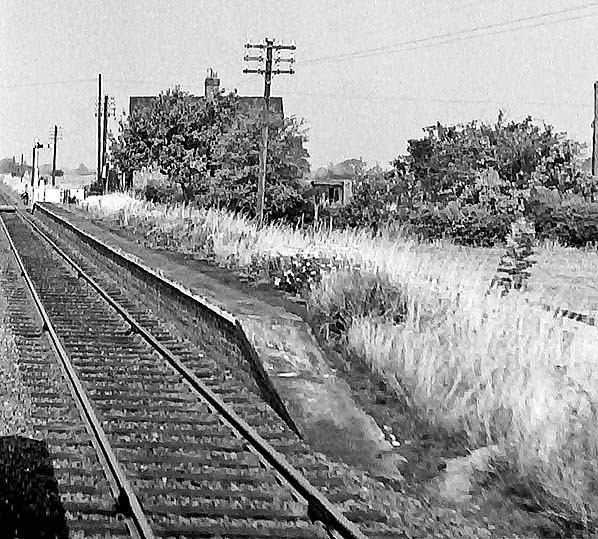
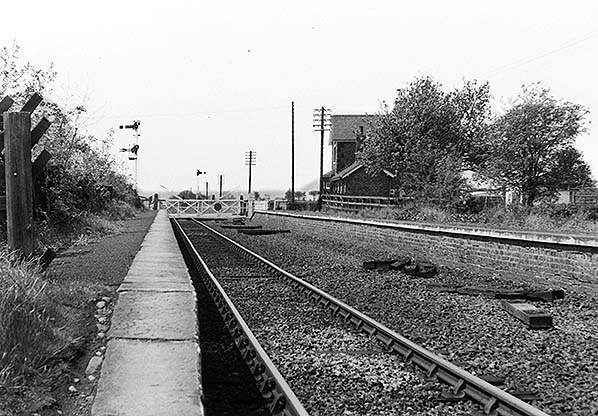
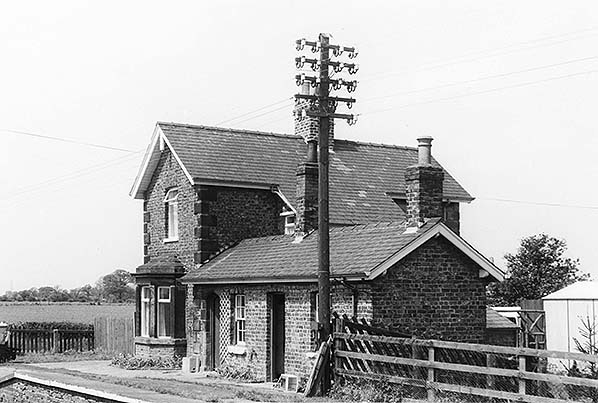
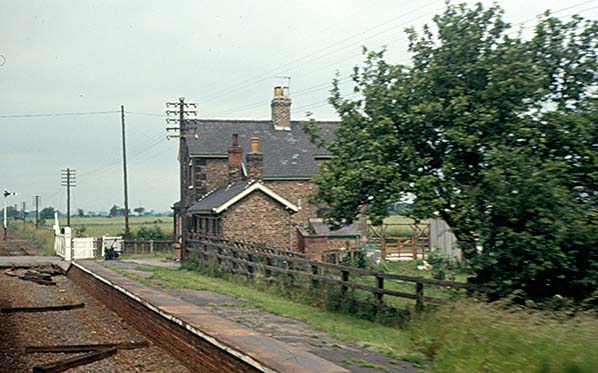
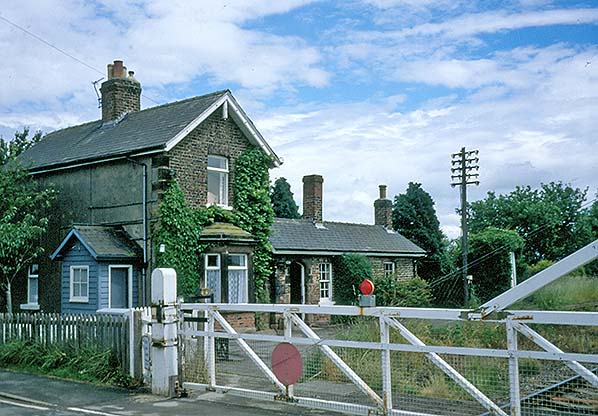
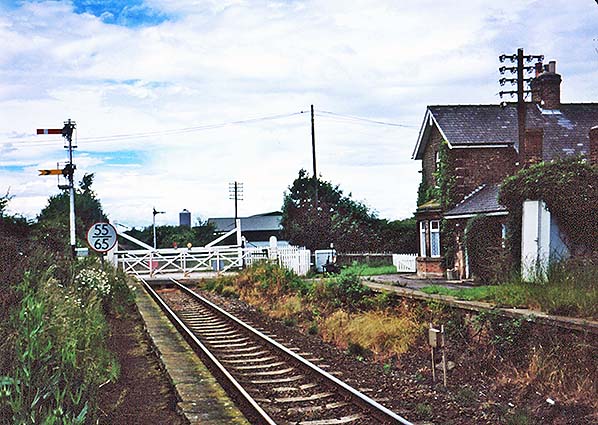
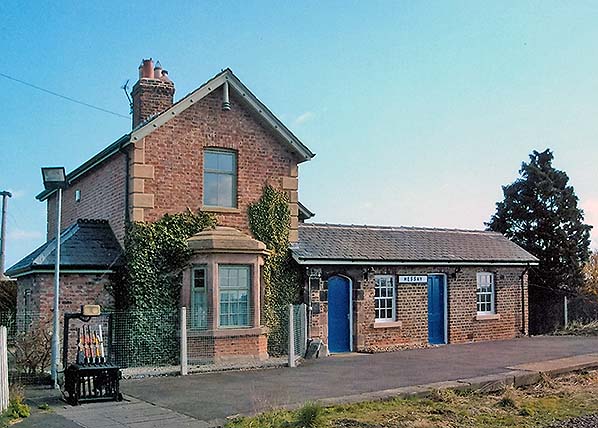
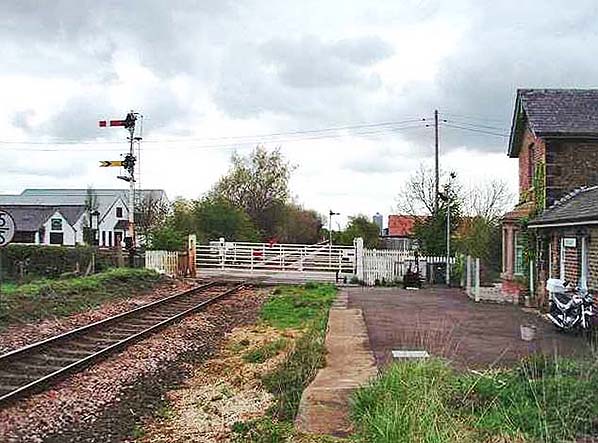
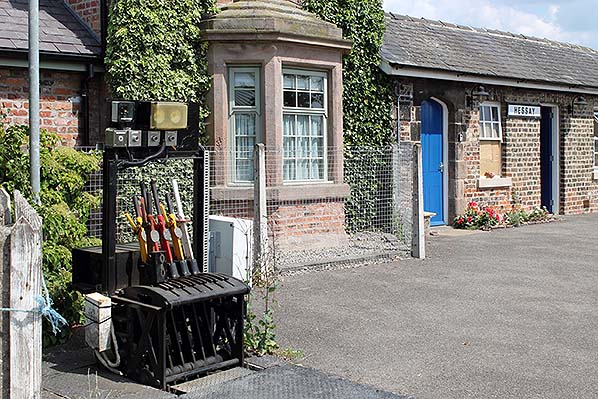
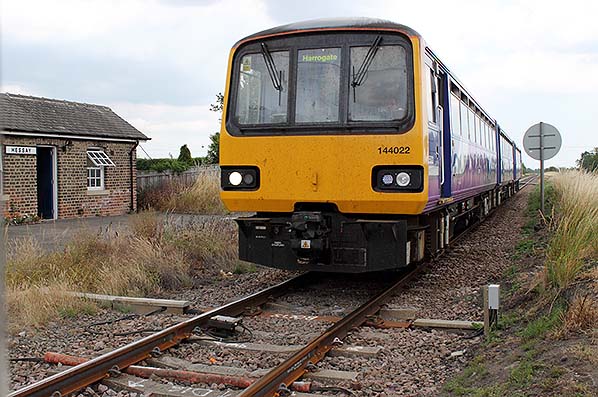
 The intention of the EWYJ was to provide three large wayside stations between York and Knaresborough at Poppleton, Marston (later Marston Moor) and Cattal; a fourth was added at Allerton (later Hopperton), and all four opened with the line in 1848. Within two years further stations were provided at Hessay, Hammerton and Goldsborough level crossings, but it is possible that trains called at these places from the opening of the line; early passenger timetables for North East England are known to have omitted certain stations that were in use. In all three places there were level crossings, where the gatekeepers’ houses could be incorporated into a passenger station. The hamlet of Hessay was about half a mile south of the level crossing promising a modest amount of passenger traffic.
The intention of the EWYJ was to provide three large wayside stations between York and Knaresborough at Poppleton, Marston (later Marston Moor) and Cattal; a fourth was added at Allerton (later Hopperton), and all four opened with the line in 1848. Within two years further stations were provided at Hessay, Hammerton and Goldsborough level crossings, but it is possible that trains called at these places from the opening of the line; early passenger timetables for North East England are known to have omitted certain stations that were in use. In all three places there were level crossings, where the gatekeepers’ houses could be incorporated into a passenger station. The hamlet of Hessay was about half a mile south of the level crossing promising a modest amount of passenger traffic.
 Owing to the decline in use of rural stations, in the 1950s the neighbouring branch line from Harrogate to Pateley Bridge closed to passengers as did the branch from Knaresborough to Pilmoor on the East Coast main line. On the York–Harrogate route all stations that survived to nationalisation remained open, but in 1952/53 economies were effected by reducing the number of train calls at the quietest stations, making the services less attractive. Hessay’s train service was almost annihilated, as seen in the summer 1958 timetable. The only worthwhile return journey that could be made by train was a shopping/market trip to York on Saturday.
Owing to the decline in use of rural stations, in the 1950s the neighbouring branch line from Harrogate to Pateley Bridge closed to passengers as did the branch from Knaresborough to Pilmoor on the East Coast main line. On the York–Harrogate route all stations that survived to nationalisation remained open, but in 1952/53 economies were effected by reducing the number of train calls at the quietest stations, making the services less attractive. Hessay’s train service was almost annihilated, as seen in the summer 1958 timetable. The only worthwhile return journey that could be made by train was a shopping/market trip to York on Saturday.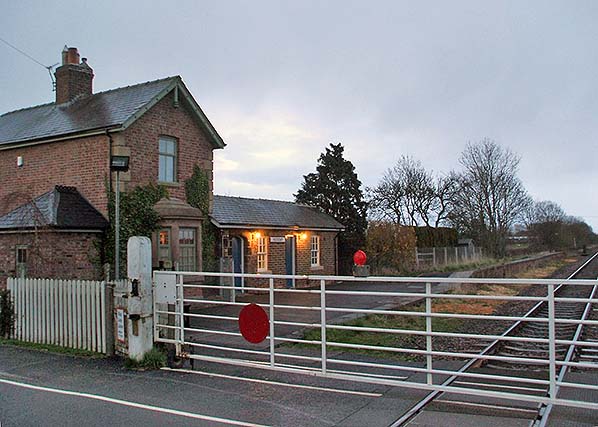




 Home Page
Home Page